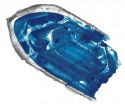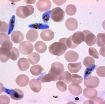(Press-News.org) A team of UConn chemists has discovered a new way of making a class of porous materials that allows for greater manufacturing controls and has significantly broader applications than the longtime industry standard.
The process, more than three years in the making, has resulted in the creation of more than 60 new families of materials so far, with the potential for many more. The key catalyst in the process is recyclable, making it a 'green' technology.
"This is definitely the most exciting project I've been involved in over the past 30 years," says Board of Trustees Distinguished Professor Steven L. Suib, the project's principal investigator.
The research team's novel process creates monomodal mesoporous metal oxides using transition metals such as manganese, cobalt, and iron. The mesopores are between 2 and 50 nanometers in diameter and are evenly distributed across the material's surface.
UConn's scientists used nitric oxide chemistry to change the diameter of the pores. This unique approach helped contain chemical reactions and provided unprecedented control and flexibility.
Having materials with uniform microscopic pores allows targeted molecules of a particular size to flow into and out of the material, which is important in such applications as adsorption, sensors, optics, magnetic, and energy products such as the catalysts found in fuel cells.
"When people think about these materials, they think about lock-and-key systems," says Suib. "With certain enzymes, you have to have pores of a certain size and shape. With this process, you can now make a receptacle for specific proteins or enzymes so that they can enter the pores and specifically bind and react. That's the hope, to be able to make a pore that will allow such materials to fit, to be able to make a pore that a scientist needs."
UConn's chemists replaced a long-standing water-based process with one employing a synthetic chemical surfactant to create the mesopores. By reducing the use of water, adding the surfactant, then subjecting the resulting nanoparticles to heat, the research team found that it could generate thermally-controlled, thermally-stable, uniform mesoporous materials with very strong crystalline walls. The mesopores, Suib says, are created by the gaps that are formed between the organized nanoparticles when they cluster together. The team found that the size of those gaps or pores could be tailored – increased or decreased – by adjusting the nanostructure's exposure to heat, a major advancement in the synthesis process.
"Such control of pore-size distribution, enhanced pore volumes, and thermal stabilities is unprecedented …," the team wrote in its report.
The UConn team found that the process could be successfully applied to a wide variety of elements of the periodic table. Also, the surfactant used in the synthesis is recyclable and can be reused after it is extracted with no harm to the final product.
"We developed more than 60 families of materials," says Suib. "For every single material we made, you can make dozens of others like it. You can dope them by adding small amounts of impurities. You can alter their properties. You can make sulfides in addition to oxides. There is a lot more research that needs to be done."
INFORMATION:
The UConn research was funded by the U.S. Department of Energy's Basic Energy Sciences division through a $420,000 grant over three years.
New process uses recyclable catalyst to create porous materials
2014-02-24
ELSE PRESS RELEASES FROM THIS DATE:
New insights into the origin of birds
2014-02-24
Mark Puttick and colleagues investigated the rates of evolution of the two key characteristics that preceded flight: body size and forelimb length. In order to fly, hulking meat-eating dinosaurs had to shrink in size and grow much longer arms to support their feathered wings.
"We were really surprised to discover that the key size shifts happened at the same time, at the origin of Paraves," said Mr Puttick of Bristol's School of Earth Sciences. "This was at least 20 million years before the first bird, the famous Archaeopteryx, and it shows that flight in birds arose ...
Policies to green the economy must underpin UK recovery: New report
2014-02-24
The UK urgently needs a green economic strategy to move towards low-carbon prosperity, resource security and environmental quality, says a new report published today by UCL's Green Economy Policy Commission.
The Commission – drawn from a range of academic disciplines across UCL – argues that the UK's current situation of climate instability and increasing resource constraints mean that decisive action is urgently needed by the UK government to green the economy.
Greening the Recovery argues that there is a window of opportunity for policies that acknowledge future ...
Mysterious polio-like illness found in 5 California children
2014-02-23
PHILADELPHIA – Researchers have identified a polio-like syndrome in a cluster of children from California over a one-year period, according to a case report released today that will be presented at the American Academy of Neurology's 66th Annual Meeting in Philadelphia, April 26 to May 3, 2014.
"Although poliovirus has been eradicated from most of the globe, other viruses can also injure the spine, leading to a polio-like syndrome," said case report author Keith Van Haren, MD, with Stanford University in Palo Alto, Calif., and a member of the American Academy of Neurology. ...
Scientists transform skin cells into functioning liver cells
2014-02-23
SAN FRANCISCO, CA—February 23, 2014—The power of regenerative medicine now allows scientists to transform skin cells into cells that closely resemble heart cells, pancreas cells and even neurons. However, a method to generate cells that are fully mature—a crucial prerequisite for life-saving therapies—has proven far more difficult. But now, scientists at the Gladstone Institutes and the University of California, San Francisco (UCSF), have made an important breakthrough: they have discovered a way to transform skin cells into mature, fully functioning liver cells that flourish ...
Oldest bit of crust firms up idea of a cool early Earth
2014-02-23
MADISON, Wis. – With the help of a tiny fragment of zircon extracted from a remote rock outcrop in Australia, the picture of how our planet became habitable to life about 4.4 billion years ago is coming into sharper focus.
Writing today (Feb. 23, 2014) in the journal Nature Geoscience, an international team of researchers led by University of Wisconsin-Madison geoscience Professor John Valley reveals data that confirm the Earth's crust first formed at least 4.4 billion years ago, just 160 million years after the formation of our solar system. The work shows, Valley says, ...
Researchers have identified a novel immunological mechanism of great importance for vaccine developm
2014-02-23
Researchers have discovered the presence of a novel subtype of innate lymphoid cells in human spleen essential for the production of antibodies. This discovery, published in the prestigious journal Nature Immunology, clears the path to the identification of novel strategies to develop more efficient vaccines against encapsulated bacteria, considered highly virulent.
This work was done by the B cell Biology research group at IMIM (Institut Hospital del Mar d'Investigacions Mediques) in Barcelona, directed by Dr. Andrea Cerutti, ICREA research professor and leader in the ...
A key protein is discovered as essential for malaria parasite transmission to mosquitos
2014-02-23
Two teams have independently discovered that a single regulatory protein acts as the master genetic switch that triggers the development of male and female sexual forms (termed gametocytes) of the malaria parasite, solving a long-standing mystery in parasite biology with important implications for human health. The protein, AP2-G, is necessary for activating a set of genes that initiate the development of gametocytes -- the only forms that are infectious to mosquitos. The research also gives important clues for identifying the underlying mechanisms that control this developmental ...
Stream of stars in Andromeda satellite galaxy shows cosmic collision
2014-02-23
The Andromeda Galaxy is surrounded by a swarm of small satellite galaxies. Researchers from the Niels Bohr Institute, among others, have detected a stream of stars in one of the Andromeda Galaxy's outer satellite galaxies, a dwarf galaxy called Andromeda II. The movement of the stars tells us that what we are observing is the remnant of a merger between two dwarf galaxies. Mergers between galaxies of such low mass has not been observed before. The results are published in the scientific journal, Nature.
The galaxies in the early universe started off small and the theory ...
Researchers pinpoint brain region essential for social memory
2014-02-23
NEW YORK, NY (February 23, 2014) — Columbia University Medical Center (CUMC) researchers have determined that a small region of the hippocampus known as CA2 is essential for social memory, the ability of an animal to recognize another of the same species. A better grasp of the function of CA2 could prove useful in understanding and treating disorders characterized by altered social behaviors, such as autism, schizophrenia, and bipolar disorder. The findings, made in mice, were published today in the online edition of Nature.
Scientists have long understood that the hippocampus—a ...
Nanoparticles target anti-inflammatory drugs where needed
2014-02-23
Researchers at the University of Illinois at Chicago have developed a system for precisely delivering anti-inflammatory drugs to immune cells gone out of control, while sparing their well-behaved counterparts. Their findings were published online Feb. 23 in Nature Nanotechnology.
The system uses nanoparticles made of tiny bits of protein designed to bind to unique receptors found only on neutrophils, a type of immune cell engaged in detrimental acute and chronic inflammatory responses.
In a normal immune response, neutrophils circulating in the blood respond to signals ...


